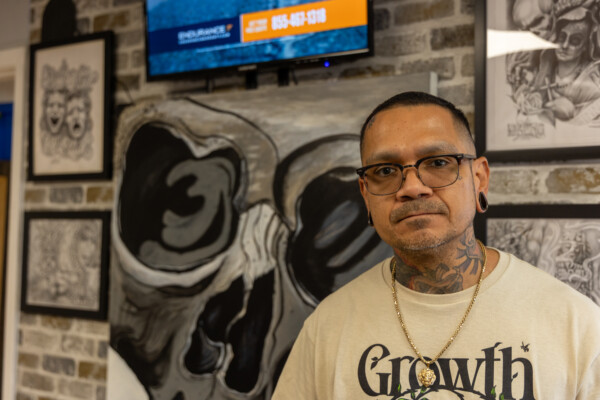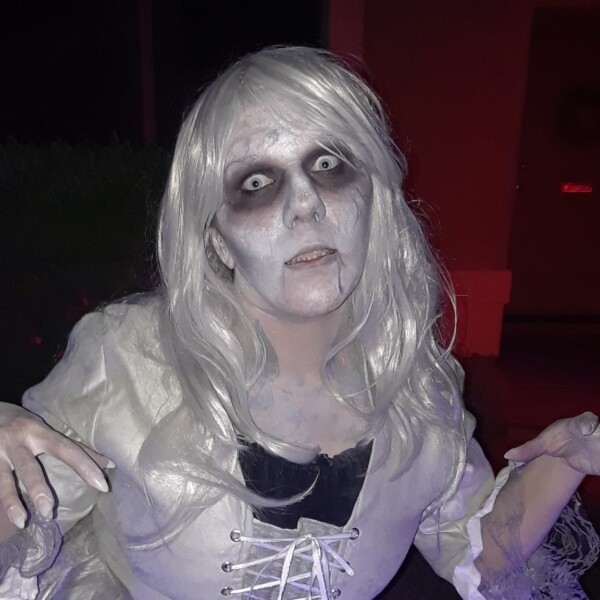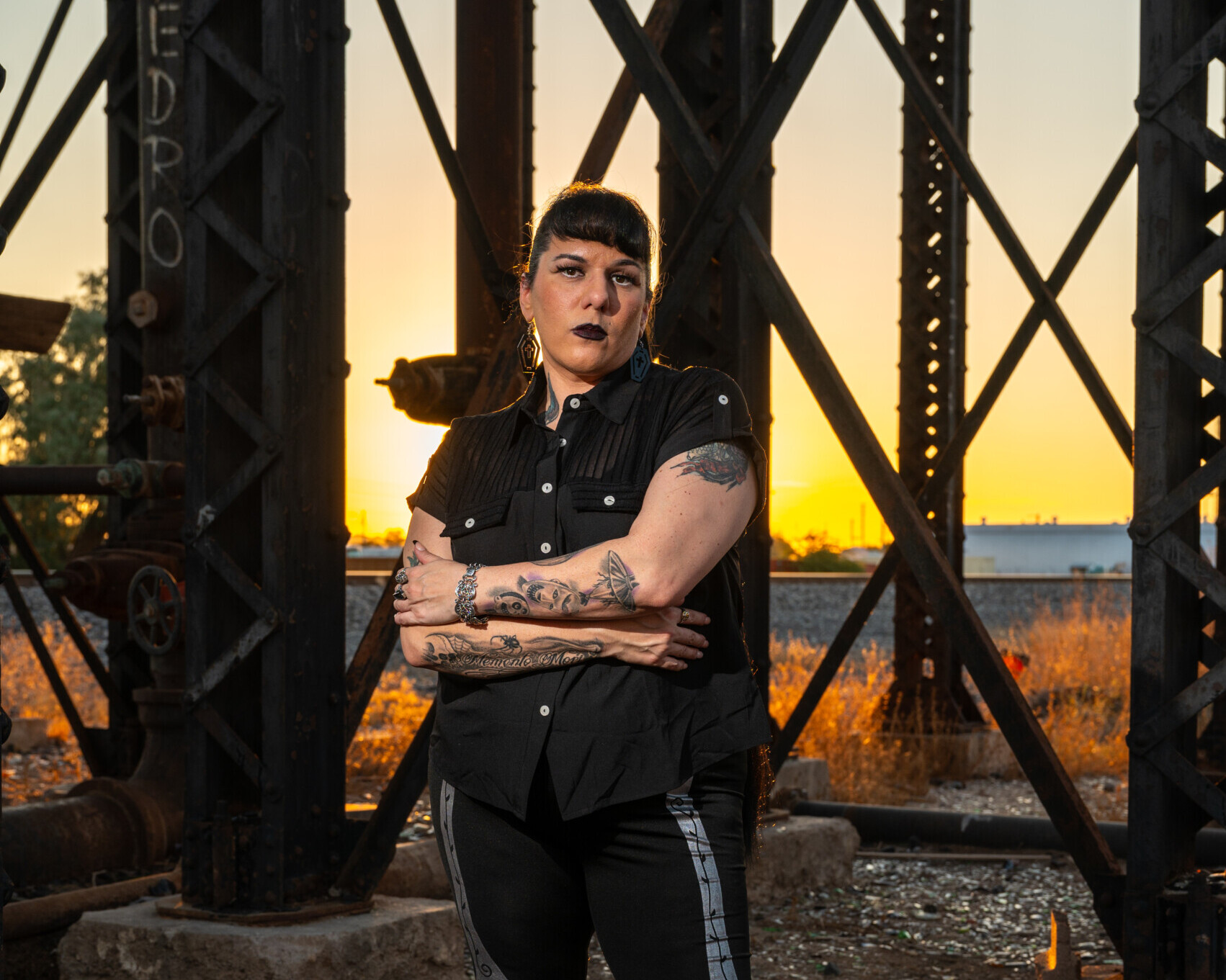Maricopa, once a bastion of barley fields and pecan groves, has traded in its cowboy hats for a darker, edgier ensemble. Forget the tractors belching plumes of smoke like storybook dragons — this desert city has a new cast of characters: skulls, spikes, pentagrams and goat-headed deities.
Amid a surge in population, an enigmatic subculture has emerged in this sun-drenched city where darkness seems paradoxically misplaced. In a world of sunseekers, these denizens of the macabre prefer to toy with life’s morbid underbelly.
They’re not your typical Phoenix urbanites, preoccupied with cosmopolitan pursuits. Among their ranks are newcomers and others who have long lingered in the shadows.
When they united for a maiden public display in Maricopa last month, it was a watershed moment — proving we are truly living in gothic times.
Two worlds
A cluster of skull-shaped cherries peeked over Angela Manzer’s pinstriped collar. She draws the eye in that Maricopa café — what with her miniature coffins for earrings and leather pants tighter than a Gibson Les Paul string.
Lips painted as black as her coffee took a sip as Manzer peered through cat-eyed frames. If the goths of Maricopa were to choose a leader, she would surely be their countess.
“When I was a kid, I got picked on for being goth,” Manzer recalled. “I remember getting spit on for wearing my mom’s black trench coat to school. People treated me like I was trying to kill somebody.”
Goth subculture has gained traction among younger Maricopans like Manzer’s 12-year-old daughter, Emily, who laments she’s not allowed to wear her spider-webbed high heels to class at Leading Edge Academy.
Manzer, 43, is a self-styled “old-school goth girl from the ‘90s.” Think Marilyn Manson, Korn and Nine Inch Nails. The community considers her an elder goth, “but I guess I earned that title,” she said.
The lifestyle she embraced at the age of 16 wasn’t exactly in vogue back then. The same held true when she traded San Francisco for Maricopa in 2010, when the rural community had little appetite for the alternative.
“We’re toeing the line between two worlds,” she said.
Crave the Dead
But in the years and months since the coronavirus pandemic, Manzer, who dons the mantle of an optical technician when she’s not studying the dark arts, noticed a turning tide amid eye exams at a Maricopa practice.
“Working at Nationwide Vision, I was seeing a lot more people who looked like me coming in to get their eyes done,” she said.
And then during industrial rock concerts at the Rebel Lounge and Crescent Ballroom in Phoenix, increasingly, she met others from Maricopa.
So, she launched Crave the Dead in April this year — a “dark entertainment” outfit offering goth trivia, goth aerobics (haven’t you ever exercised in the dark?) and on Sept. 23, the first-ever, all-out goth festival in Maricopa.

“Dieonysis” (pun very much intended) was a pivotal moment for the city’s burgeoning goth community. Veiled merchants purveyed their occult trinkets to the sound of death metal and the hum of a tattoo gun.
“There has never been anything in this town that is remotely for us,” Manzer said. “There still isn’t — except for this damn show.”
Manzer has been active in the community for as long as she’s lived here.
She’s the woman behind other Maricopa businesses, like A Leg Up Tutoring and Angela’s Cakes & Things.
“I feel like I’m a staple part of the Maricopa community,” Manzer said. “I really built roots in this community.”
And yet, in a way, she’s putting her genuine self on display for the very first time.
That’s so metal
Manzer spent much of her career in education, working stints at Santa Cruz Elementary School and Leading Edge Academy.
Brad Turnbow used to work in education, too, at Maricopa High School and Legacy Traditional School. Until he gave it up one day in 2016, changed his name to SpellXCaster and became a goth guitarist instead.
“I started making music in Maricopa,” Turnbow said.
He found his muse juxtaposing the quiet, sunlit countryside with music both loud and dark.
“I went to that mysterious place in my mind as I ran through the cornfields,” he said. “It’s like escaping to a dark new world.”

In the cradle of small towns like Maricopa, a sort of rural-meets-metal scene crops up — the rise of gothic cowboys. Take, for instance, the Las Vegas metal band Falling in Reverse and their unapologetically conservative, anti-woke anthem “Zombified” released last year.
That outcast thing
Emily Bauman-Heieie opened A Cut Above Handmade on a whim during the coronavirus pandemic.
The shop on John Wayne Parkway sells such items as bloody newspaper clippings of serial killers.
“Everything is horror themed all year long,” Bauman-Heieie said. “Back when Maricopa was a small town, I don’t think it would have sold. Today, there is a community out here in Maricopa that loves what I do.”
Other business owners in Maricopa noticed the city’s goth-ification since the pandemic. Take Nick Sanchez, tattoo artist and owner of Redemption Tattoo on North Maricopa Road
Sanchez was a teen in Mesa in the 1990s, a time when tattoos of skulls and scythes came from homemade tattoo machines in “the hood,” and were a far cry from the mainstream.
“I like goth, dude,” he said. “It’s like a popular fad now, all of a sudden. Especially with younger kids. Even the parents of those younger kids.”
Sanchez did many of Manzer’s tattoos, and they cover her like a second skin. She’s got bats, skulls and even a ghost holding a butcher’s knife on her shoulder.
“The foundation of the goth world is the macabre — everything that is death, spooky, freakish or taboo to society in some way,” she said. “It’s that outcast thing.”
We live in gothic times
“Outcast” implies a sort of avant-garde counterculture. Why, in just the last three years, have so many reported goths made their ingress to the normie world?
![Gothic art lines the walls of Redemption Tattoo. [Elias Weiss]](https://www.inmaricopa.com/wp-content/uploads/2023/09/BPJ_5286-600x400.jpg)
This timeline seems universal — Maricopa isn’t far behind the Valley, where the Arizona Goth Society held the state’s first goth festival in Mesa just last year. On Oct. 28, they’ll gather in Maricopa for an organized ghost hunt.
In 1974, English novelist Angela Carter posited, “We live in gothic times.” Think Vietnam, Watergate and the Oil Crisis.
But the ’70s were mere prologue to the tumultuous early ’20s, marked by profound political turmoil in the U.S. and a once-in-a-century pandemic claiming millions of lives.
The pandemic brought fear, claustrophobia and isolation. It’s a perfect storm for a goth resurgence.
After all, the Arizona Goth Society was created directly “in response to the pandemic,” according to its founders.
When you see goth people in Maricopa doing goth things, don’t misunderstand them — although they’re used to it. Being misunderstood is kind of their whole schtick. Well, part of it, at least.
“We’re not scary or horrible people in any way,” Manzer said. “Even if we are angry, we are outcasts, we are alternative. We’re the nicest people you’ll ever meet.”
This story was first published in the October edition of InMaricopa Magazine.







![City gave new manager big low-interest home loan City Manager Ben Bitter speaks during a Chamber of Commerce event at Global Water Resources on April 11, 2024. Bitter discussed the current state of economic development in Maricopa, as well as hinting at lowering property tax rates again. [Monica D. Spencer]](https://www.inmaricopa.com/wp-content/uploads/2024/04/spencer-041124-ben-bitter-chamber-property-taxes-web-218x150.jpg)

![3 things to know about the new city budget Vice Mayor Amber Liermann and Councilmember Eric Goettl review parts of the city's 2024 operational budget with Mayor Nancy Smith on April 24, 2024. [Monica D. Spencer]](https://www.inmaricopa.com/wp-content/uploads/2024/04/spencer-042424-preliminary-budget-meeting-web-218x150.jpg)


![Alleged car thief released without charges Phoenix police stop a stolen vehicle on April 20, 2024. [Facebook]](https://www.inmaricopa.com/wp-content/uploads/2024/04/IMG_5040-218x150.jpg)





